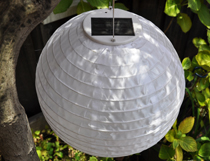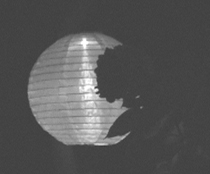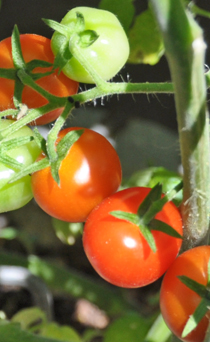March 8, 2025. It’s Better than Cheaper. It’s Free. So ask not how daylight can save you. Ask how you can save daylight. And consider these answers.
The Little LED Lantern That Could
This thing spends the day sunbathing. It stores the sunlight in a little battery. Then it lights up when the sun goes down. I bought it because I knew it would be cool. I’m interested in this technology, so how could I not get this groovy looking faux Japanese lantern with a built in photovoltaic cell, a storage battery, a photosensor and an LED light?
Well, I got it and hung it on a tree branch to see if it would actually work. Sure enough, it got dark six hours later — and the thing turned itself on. Cool. A couple of nights later, I look out the window and see this softly glowing sphere and I feel strangely drawn to it, like I’m a werewolf or something. I’m compelled to go out and give it a good look. At which point I realize this isn’t cool – this is profoundly cool. This is a definitive seeing-is-believing, OMG, this-is-how-it’s-going-to-be-someday moment. Totally free, totally clean energy.
Day after day after day … just like the sun. It’s one thing to know about a technology – it’s another thing to see it work. And know that it does. This device is the ultimate time-shifting technology: it recycles daylight into nightlight.
Want to buy a LED Light Bulb? Click to see how spending $20 now can save you $200 over the next 20 years. And save you from having to change the bulb again for 20 years.
Just add water
Time to plant some plants. Any of those green, photosynthetic things that convert all that daylight into the food and flowers you know and love.
Which lucky members of the plant kingdom will be the objects of your attention and desire a few weeks from now? Do you go for the trifecta: look good, smell good and taste good. The tomatoes and peppers and cukes that prove you, yes, you, can grow food you can eat. Food that, spacey as it sounds, gives you a profound connection to eating. That heightens your appreciation for real, fresh food. And for farmers.
Or do you say, two outta three ain’t bad, and go for some good-looking, good-smelling flowers. Which is not settling for some second best. I mean, good-looking-good-smelling gives great pleasure. More than you can say for some humans you know.
What I planted last year:
Heirloom strawberries of the Alpine Mignonette variety. Small and very sweet.
Brandywine, Green Zebra and Marvel Stripe tomatoes
Mild Padron peppers
Not-so-mild Ancho & Jalapeno peppers
Cilantro (Coriander)
Italian Parsley
“Whirlybird” Nasturtium
French green beans
Batteries not included
What a deal. Sunlight’s free and you don’t even have to strap a solar panel to your back to use it. Just take off your shirt. Or your pants.
Because your skin synthesizes Vitamin D – a lot of it – when it’s exposed to sunlight. But get this: most of us are Vitamin D-deficient. And this matters a lot. As more studies focus on it, Vitamin D-deficiency looks more and more like a causal factor in everything from obesity to arthritis to high blood pressure to diabetes to breast, colon and other forms of cancer.
Sure, Vitamin D’s about bone health, too – because without Vitamin D you can’t absorb and use calcium to strengthen and maintain your bones. But it’s about much more. Vitamin D is actually a hormone that’s centrally involved in your metabolism – and in muscle, cardiac, immune and neurological functions.
So while the days get longer and sunlit hours multiply, you might want to rethink your relationship with the sun. I’m not suggesting sun worship. I’m just thinking that, when it comes to the sun, the only thing we have to fear is fear itself. For much more information and a big chart that tells you how much sun exposure is sensible, safe and beneficial for you, read The Vitamin D Solution. Written by Michael Holick, Ph.D., M.D., the man responsible for the first isolation and identification of the active form of Vitamin D.
The Vitamin D Solution is not an excuse for a tan. It advocates a “sensible amount of unprotected sun exposure“. What’s ‘sensible’? “Our richest source of Vitamin D is the sun. Most of us need only a few minutes a day of sun exposure during the summer months to maintain healthy Vitamin D levels throughout the year.”
If you still want to keep your face out of the sun, that’s OK. It’s only 9% of your skin. Your legs are 36%. Your arms are 18%. Your back: another 18%. So take off your shirt. And/or your pants.
If this has you re-thinking your relationship with the sun, check out the book – especially the eight-page “Holick’s Sensible Sun Table” to calculate how much sun you should get based on your skin type and where you live. And what time of year it is. The best time’s coming soon.
Cost Benefit Analysis
$10 for a definitive seeing-is-believing experience of totally free, totally clean energy. I bought mine at Crate & Barrel, but they sold out. I found this one online. They look identical to mine.
Let’s Do The Math
The U.S. Department of Energy estimates that widespread adoption of LED lighting in the U.S. over the next 15 years can:
Deliver savings of about $280 billion.
Avoid 133 new power plants
Reduce lighting electricity demand by 62% in 2025.
Eliminate 258 million metric tons of carbon emissions.




